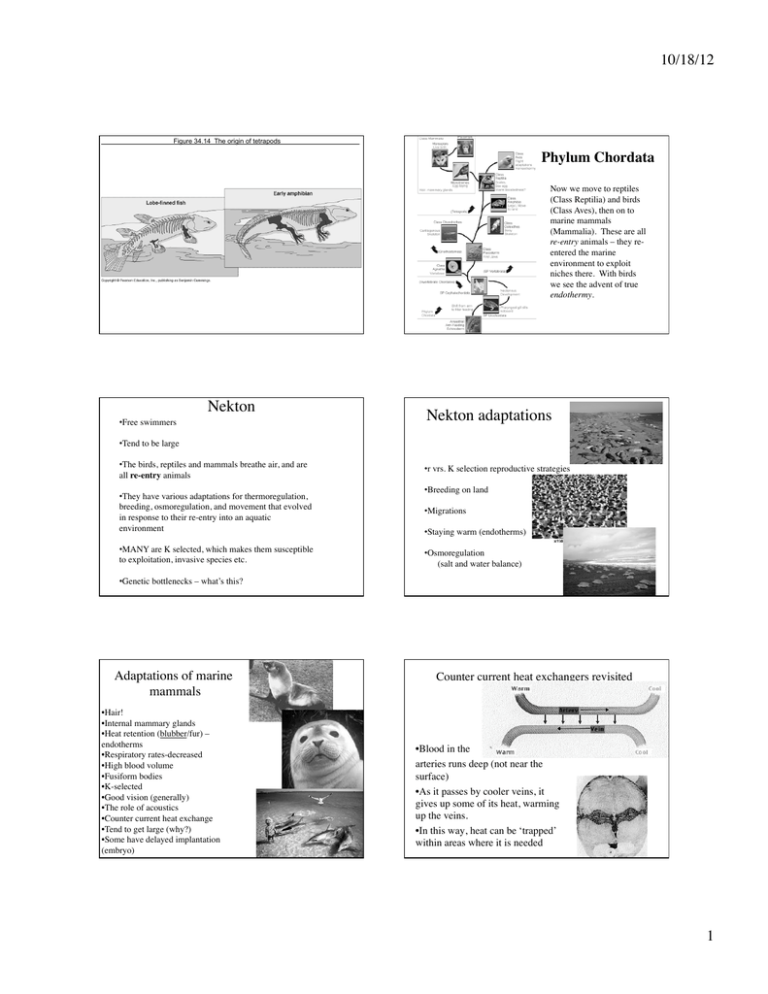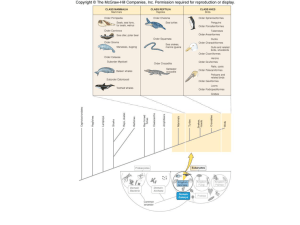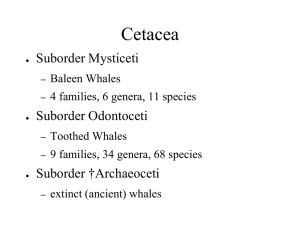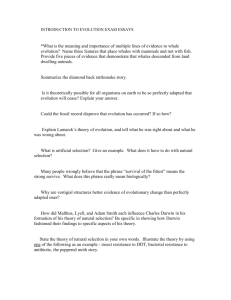Document 13036535
advertisement

10/18/12 Figure 34.14 The origin of tetrapods Phylum Chordata Now we move to reptiles (Class Reptilia) and birds (Class Aves), then on to marine mammals (Mammalia). These are all re-entry animals – they reentered the marine environment to exploit niches there. With birds we see the advent of true endothermy. Nekton • Free swimmers Nekton adaptations • Tend to be large • The birds, reptiles and mammals breathe air, and are all re-entry animals • They have various adaptations for thermoregulation, breeding, osmoregulation, and movement that evolved in response to their re-entry into an aquatic environment • MANY are K selected, which makes them susceptible to exploitation, invasive species etc. • r vrs. K selection reproductive strategies • Breeding on land • Migrations • Staying warm (endotherms) • Osmoregulation (salt and water balance) • Genetic bottlenecks – what’s this? Adaptations of marine mammals • Hair! • Internal mammary glands • Heat retention (blubber/fur) – endotherms • Respiratory rates-decreased • High blood volume • Fusiform bodies • K-selected • Good vision (generally) • The role of acoustics • Counter current heat exchange • Tend to get large (why?) • Some have delayed implantation (embryo) Counter current heat exchangers revisited • Blood in the arteries runs deep (not near the surface) • As it passes by cooler veins, it gives up some of its heat, warming up the veins. • In this way, heat can be ‘trapped’ within areas where it is needed 1 10/18/12 Order Sirenia: Manatees and dugongs Dugongs: Dugong dugon 4 species: 3 Manatees and 1 dugong There used to be the Steller’s Sea Cow – extinct now ? Natural history of Dugongs Live over 70 years, K-selected Sexually mature between 10 and 18 years! 13-15 month gestation Nurse for another 14 months Leave mom when mature! Sirenia Manatees Trichechus IUCN redlisted (close to extinction) Southeast Asia, Africa, Australia Monophyletic (closely related to) elephants First appeared about 56 million years ago Eat seagrass Natural history of Manatees Live over 60 years, K-selected Sexually mature between 10 and 18 years! 12-13 month gestation Nurse for another 18 months IUCN redlisted (close to extinction) Amazon, West Africa, West Indian 45 meter long intestines! Monophyletic (closely related to) elephants First appeared about 56 million years ago Eat seagrass and mangroves and over 60 species of plants 2 10/18/12 Boat strikes Cetaceans (order Cetacea): whales and dolphins Evolution Feeding and reproduction Conservation status Natural history Physiology 3 families of Mysticetes Other threats: red tides, habitat degradation, hunting, pollution Archaeoceti 6 families of Odontocetes Most Archaeocetes had hind limbs – terrestrial life They evolved from From Artiodactlyls – even toed ungulates: pigs hippos, camels. Most likely ancestor were hippo-like (about 65mya) Its thought that Archaeocetes re-entered the water about 55 MYA Basilosaurs emerged from the Archaeocetes, about 34mya. They were truly aquatic Basilosaurus Two suborders of Cetaceans Cetaceans Mysticetes: baleen whales 3 families: Balaenidae, Balaenopteridae, Eschrichtiidae Odontocetes: toothed whales 6 families: Physeteridae, Monodontidae, Delphinidae, Ziphiidae, Platanistidae, Phocoenidae 3 10/18/12 Mysticeti: bearded Baleen • Baleen • 2 blowholes • Largest of the whales: 100 ft, 160 tons! Humpback baleen Gray whale baleen http://www.youtube.com/watch?v=fOMzFFh3rEA Straining/Skimming Feeding • Gulp feeding • Bubble nets: Humpbacks http://www.youtube.com/watch?v=vJvfjiCTvq4 Balaenidae:right whales • No ventral grooves • No dorsal fin • Polar waters • Moderate migrations • Heavily exploited Blue Whale: Krill http://www.youtube.com/watch? v=k2lAf5j4ou0 Bowhead Right whales Pygmy right whale Bowhead: copepods (fine baleen) http://www.youtube.com/watch?v=r8DuJy27OjI 4 10/18/12 Northern Right Whales Eubalaena glacialis 300-400 left Major cause of mortality: ship strikes Balaenopteridae • Numerous ventral grooves • Fast swimmers • Small dorsal fin, far back on the back • Extensive migrations Balaenopteridae: rorquals Balaenopteridae Balaenopteridae: Humpbacks Blue whales 5 10/18/12 Eschrichtiidae: gray whales Gray whales: Eschrichtius robustus • Few ventral grooves • Dorsal knuckles • Bottom feeders • extensive migrations The only whales to feed on the bottom (on benthic amphipods) Mysticetes Remember those blow holes? Are LARGE Are endangered Are K-selected Undertake long migrations (most) Feed with baleen in a variety of ways Are not particularly social… We looked at three families Odontoceti • Teeth • Smaller (ex. sperm whale) • Highly social • Sophisticated sonar • deep divers • One blowhole • Predators • short or no migrations • temperate/tropical Odontocetes: the human factor 6 families of toothed whales 6 10/18/12 The human factor http://www.youtube.com/watch?v=TMCf7SNUb-Q The other side of the story http://www.youtube.com/user/ XcaretPark?v=4-CUA7dQKdg Private lives of Dolphins… http://www.youtube.com/watch?v=T7AlinxwVAg Delphinidae (dolphins) in particular have complex social systems and tight knit alliances They have very large brains Its about those giant squid… Physeteridae: sperm whales • Deep divers • Large spermaceti organ in head • Matriarchial (female) societies • Largest of the odontocetes • Temperate waters http://www.youtube.com/watch? v=_NpZLhqly8s Can dive up to 7,000 feet, and stay for more than an hour 7 10/18/12 Odontocete whales Monodontidae: Narwhals and white whales (beluga) • Flexible head • Cold arctic waters Monodon monoceros – the narwhal Lives in the arctic ocean Lack of dentition other than the tusk – only found in males! Like the beaked whales – probably ‘suck’ up their prey. Eat cod and other fish and squid* Still hunted by Native Americans/Alaskan/Canadian tribes What about that tusk anyway… Delphinapterous Leucas – Beluga whale Delphinapterous Leucas – Beluga whale Lives in the Arctic 7 neck vertebrae are not fused –flexible neck! Still hunted Opportunistic feeders: fish, invertebrates, squid Extremely high levels of contaminants in their fat PCBs, and pesticides like DDT, HCB, HCH, chlordane and toxaphene 8 10/18/12 Ziphiidae: beaked whales • Least known group • Very deep divers • In some only the males have teeth • Some known only from strandings Erupted teeth are a secondary sexual charcteristic (males) Northern Bottlenose whale Hyperoodon ampullatus Beaked whales Can dive to over 6,000 feet Can stay down for over 80 minutes Only 3 or 4 species of 21 are reasonably well known Most have only one pair of teeth Females usually have none Teeth may be the key to female attention… Sexual maturity is at about 15 years Age? 56yrs? 84 yrs? Dolphins and porpoises Dolphins: • conical teeth • falcate dorsal fin • usually have a more prominent beak Delphinidae: dolphins Porpoises: • Spade shaped teeth • triangular dorsal fin • blunt head • less social Risso s dolphin • Highly social • Sophisticated sonar • Includes killer whales and dolphins 9 10/18/12 Oceanic Dolphins Phocoenidae: Porpoises • Less social than delphinidae • travel in smaller groups • tend to be small in size Delphinidae Porpoises Phocoena phocoena Harbor porpoise Platanistidae: river dolphins River dolphins 4 living species in fresh water • Highly endangered • poor eyesight • long rostrum (beak) • good sonar • small groups Baiji – Chinese river dolphin – extinct 2006 10 10/18/12 Other marine mammals 11





